Annapurna Base Camp Trek
Have you ever wondered about the allure of the Annapurna Base Camp Trek? The theory that this trek is a transformative journey awaits validation.
As trekkers ascend higher into the Himalayas, they encounter a world where nature’s grandeur meets human resilience. The trail promises not just physical challenges but also moments of profound connection with the mountains and the local culture.
What secrets lie beyond each bend, waiting to be discovered? The answer lies in the unfolding of an adventure that beckons those who seek a deeper understanding of themselves and the world around them.
Key Points
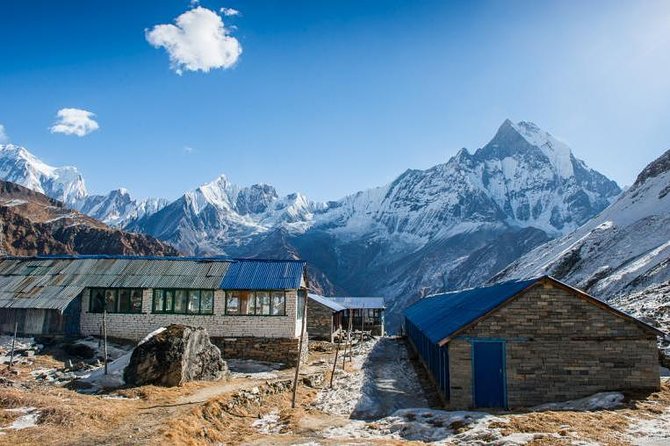
- Obtain necessary permits and adhere to regulations for a smooth trekking experience.
- Plan your visit during the best seasons for ideal weather conditions and breathtaking views.
- Pack essential gear with a focus on comfort, warmth, and organization in waterproof sacks.
- Prioritize acclimatization, hydration, and proper nutrition to prevent altitude sickness and ensure a safe journey.
Trekking Permits and Regulations
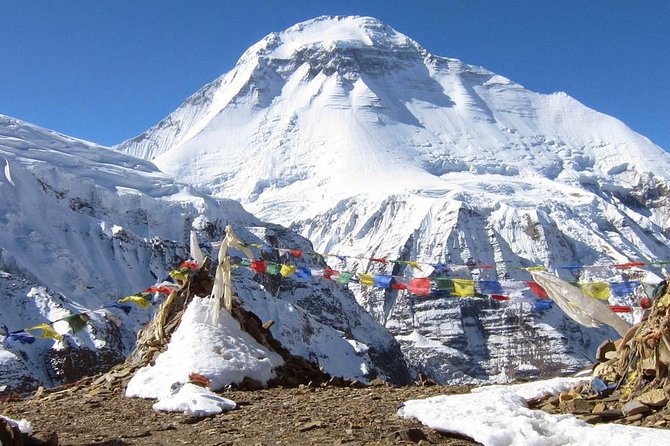
When embarking on the Annapurna Base Camp Trek, trekkers must ensure they have the necessary permits and adhere to the set regulations to explore this breathtaking region responsibly.
Trekking regulations in the Annapurna region are in place to preserve the natural beauty and ensure the safety of both trekkers and the environment. It’s essential to obtain the required trekking permits before starting the journey.
Permit requirements vary depending on the season and specific trekking route chosen. Trekkers are advised to check the latest regulations and permit conditions to avoid any issues during their trek.
Best Time to Visit Annapurna Base Camp
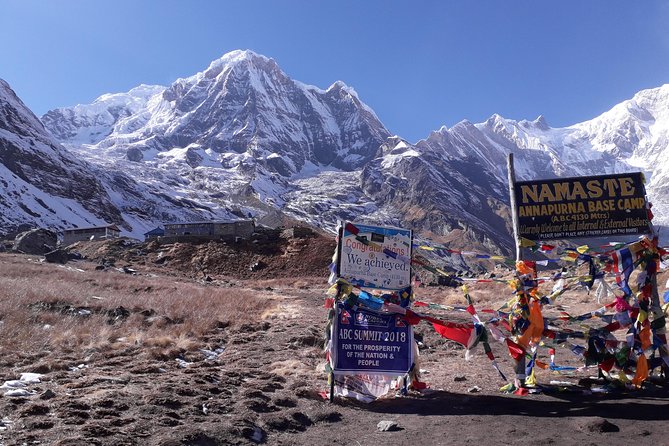
For the optimal experience at Annapurna Base Camp, timing your visit is crucial to ensure favorable weather conditions and stunning views of the surrounding peaks. The best time to visit Annapurna Base Camp is during the spring (March to May) and autumn (September to November) seasons when the weather is generally clear, offering excellent visibility and pleasant temperatures for trekking. During these months, you can expect moderate temperatures during the day and clear skies, making it ideal for capturing the majestic beauty of the Himalayas. It’s essential to plan your trip during these periods to avoid the monsoon rains and harsh winter conditions that can disrupt travel logistics and limit visibility.
| Best Time to Visit | Weather Conditions |
|---|---|
| Spring (March to May) | Clear skies, moderate temperatures |
| Autumn (September to November) | Pleasant temperatures, excellent visibility |
Packing Essentials for the Trek
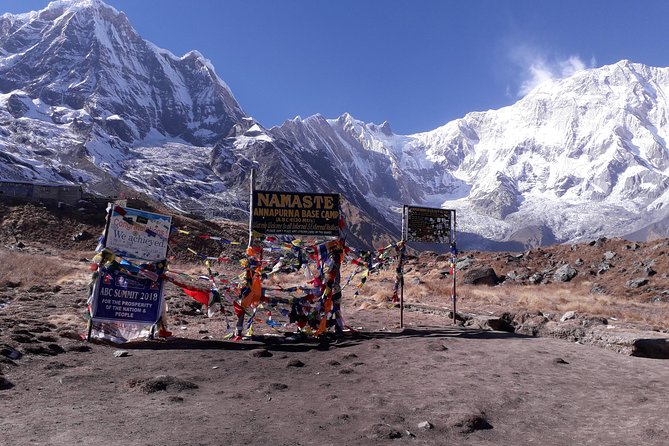
A well-prepared trekker should pack essential items to ensure a safe and enjoyable journey to Annapurna Base Camp. Gear recommendations include sturdy hiking boots, a good quality backpack, trekking poles for stability, a warm sleeping bag, and a reliable headlamp.
Packing tips suggest organizing gear in waterproof stuff sacks to keep items dry in case of rain or snow. Weather conditions at Annapurna Base Camp can vary, so it’s crucial to pack layers such as moisture-wicking base layers, insulating mid-layers, and a waterproof jacket.
Clothing choices should prioritize comfort and warmth, with items like thermal underwear, fleece jackets, and quick-drying hiking pants. These essentials will help trekkers stay prepared for the diverse conditions encountered along the trail.
Acclimatization and Altitude Sickness
As trekkers ascend to higher elevations towards Annapurna Base Camp, understanding acclimatization and recognizing the symptoms of altitude sickness becomes paramount for a safe and enjoyable journey. Preventing altitude sickness and acclimatization techniques are crucial for a successful trek.
Here are some tips to help you acclimatize effectively:
- Hydration: Drink plenty of water to combat dehydration, a common trigger for altitude sickness.
- Pacing: Take it slow and allow your body time to adjust to the increasing altitude.
- Proper Nutrition: Ensure you eat well-balanced meals to maintain your energy levels and aid in acclimatization.
Route Options and Itinerary
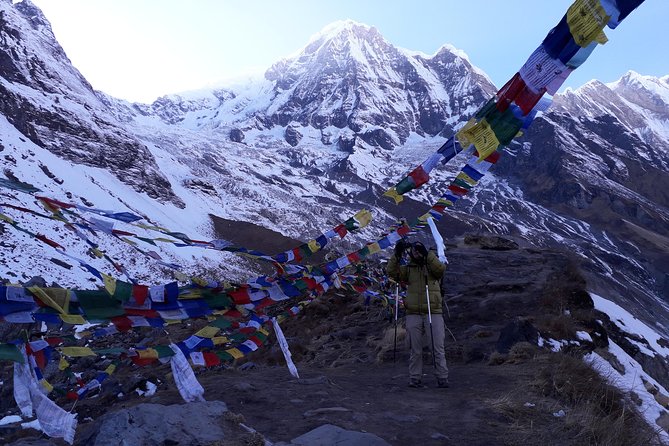
Navigating the diverse terrain towards Annapurna Base Camp offers trekkers a range of route options and itineraries to tailor their adventure to suit their preferences and abilities. Trekkers should consider the weather conditions during their chosen trekking season. The spring (March to May) and autumn (September to November) months offer the best weather for trekking, with clear skies and moderate temperatures.
As for local cuisine, hikers can savor traditional Nepali dishes like dal bhat (rice and lentils) and momos (dumplings) along the way. It’s not just a trek; it’s an opportunity to take in the local culture through food.
Choosing the right route and itinerary can enhance the overall experience of the Annapurna Base Camp trek.
Accommodation and Facilities
Enhancing the trekking experience, trekkers can look forward to comfortable accommodations and essential facilities along the Annapurna Base Camp route.
-
Accommodation Options: Trekkers can choose from a variety of lodging options ranging from cozy teahouses to basic lodges, providing a warm and welcoming place to rest after a day of trekking.
-
Dining Choices: Along the route, there are numerous dining choices offering a range of local and international dishes to cater to different tastes and dietary requirements.
-
Facilities: Basic amenities such as hot showers, charging stations, and Wi-Fi are available at most accommodations, ensuring trekkers can stay connected and refreshed throughout their journey.
These accommodation options and dining choices add convenience and comfort to the unforgettable Annapurna Base Camp trekking experience.
Safety Tips and Emergency Contacts
For trekkers embarking on the Annapurna Base Camp journey, prioritizing safety through preparedness and knowing emergency contacts is crucial. While exploring the stunning Himalayan landscapes, it’s essential to carry communication devices like satellite phones or personal locator beacons for emergencies.
In case of any unforeseen circumstances, trekkers should have quick access to emergency contacts such as local authorities, tour guides, or rescue services. Before setting off on the trek, ensure that these contacts are saved in your phone and easily accessible. Plus, familiarize yourself with the emergency procedures and protocols recommended for the Annapurna region.
Common questions
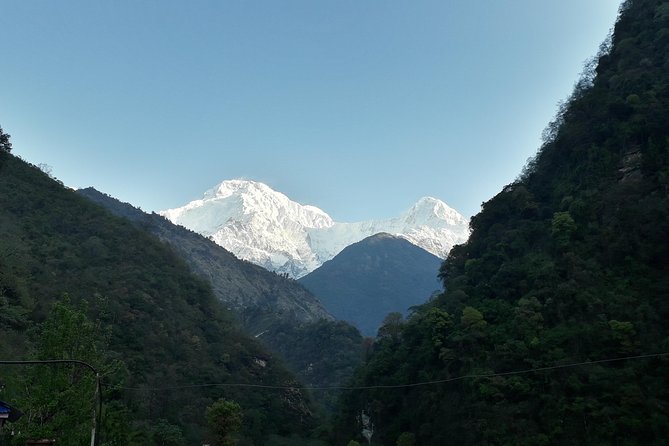
Are There Any Age Restrictions for the Annapurna Base Camp Trek?
Age restrictions and health requirements vary for different treks. It’s important to check the specific guidelines for each adventure. Always prioritize safety and consult with tour operators to ensure the journey is suitable for all participants.
What Are the Bathroom Facilities Like Along the Trekking Route?
When trekking, ensuring toilet hygiene and proper waste management is essential. Facilities along the route vary, from basic pit toilets to more developed ones. It’s crucial to maintain cleanliness and respect the environment during your journey.
Is It Possible to Hire a Porter or Guide for the Trek, and How Much Does It Cost?
Yes, it is possible to hire a porter or guide for the trek. The cost comparison between local and international guides varies, with local guides generally being more affordable. Travelers should consider their budget and preferences when making this decision.
Are There Any Specific Cultural Considerations or Dress Codes to Be Aware of During the Trek?
When exploring new cultures, it’s essential to respect local customs. Cultural etiquette involves being mindful of traditions and norms. Dress codes may vary, so it’s wise to dress modestly and appropriately to show respect.
Can I Use Credit Cards or ATMs Along the Trekking Route, or Should I Bring Enough Cash With Me?
Credit card use along the trekking route can be limited, so it’s advisable to bring enough cash. ATM availability may be scarce, so having cash on hand is essential. It’s better to be prepared for any situation.
Last Words
Embarking on the Annapurna Base Camp Trek is an adventure of a lifetime, where every step taken leads to breathtaking views and unforgettable experiences.
From the snow-capped peaks to the warm hospitality of local villages, this trek offers a perfect blend of nature and culture.
Remember to pack wisely, acclimatize properly, and follow safety guidelines to make the most of this incredible journey through the Himalayas.
Get ready to create memories that will last a lifetime!